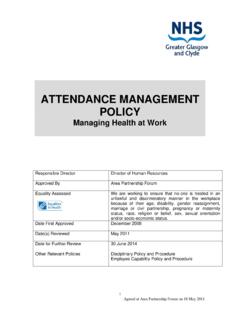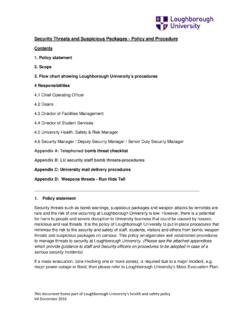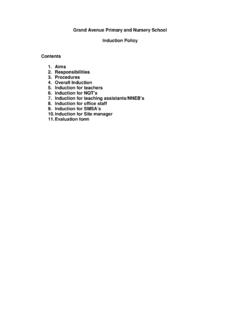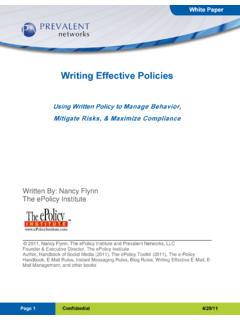Transcription of MANAGING DISABILITY AND ABSENTEEISM IN …
1 MANAGING DISABILITY AND ABSENTEEISM IN THE WORKPLACEM. Elizabeth KeenanMathews, Dinsdale & Clark LLPM arch 2012 IntroductionAn employee who is away from work due to illness often causes the employer some degree offrustration, as unexpected absences, whatever the reason, can be detrimental to productivity andefficient operation of the workplace. There are direct costs associated with paid sick leave or otherbenefits, as well as the difficulty in finding replacement workers. There also exist indirect costs suchas reduced service to the community and damage to the morale of other employees who are calledupon to cover for absent generally understand that some degree ofabsenteeism is to be tolerated as a cost of doing business.
2 However, where an employee startsmissing an excessive amount of work, his or her ABSENTEEISM becomes MANAGING DISABILITY and ABSENTEEISM in the workplace requires that an employer have theknowledge and the understanding of a myriad of DISABILITY -related legal issues arising out of bothstatutory and common , addressing attendance issues is typically a two-stageprocess: (1) finding a way to encourage regular, predictable attendance at work, or if unsuccessful,1 Health Employers Assn. of British Columbia (Re), [2002] No. 112 [Health Employers Assn.]at para. 2 -then (2) finding a means to terminate the employee s employment so as to free up resources forsomeone more reliable, without running afoul of theHuman Rights paper will address the realm of factors to be considered by employers in MANAGING absenteeismin the workplace as well as the employer's obligations pursuant to human rights and workers compensation legislation.
3 The paper will also address various concerns in relation to the cessation ofthe employment relationship, namely, the viability of the frustration of contract argument and doublerecovery AbsenteeismEmployers are entitled to expect regular ongoing attendance from their employees. Poor attendanceon the part of an employee is one of the most difficult problems an employer will be required tomanage in the context of the employment are essentially two kinds of absences: culpable and innocent/non-culpable. Regardless ofwhether an employee's absences are culpable or innocent, it is important to have a proactiveprogram in place for addressing and MANAGING that there is an ABSENTEEISM ProblemIn order to determine whether there is an ABSENTEEISM problem, an employer may consider doing (through computer reports or other company records) the total number ofdays off and number of separate instances of ABSENTEEISM for each employee withinthe last one month, three months and 12 months.
4 The worst 10% (or other % below which there is a significant gap) in eachmonitoring time period (because some employees will be in the worst 10% in oneperiod but not in others); the reasons for absence one lengthy maternity leave or leave due to astroke does not merit corrective action even if the employee is in the worst 10%; whether there is a pattern of absences (Fridays, long weekends, etc.); with the worst cases first, as employees will quickly learn that the employer willnot tolerate inexcusable/suspicious of the Nature of the ABSENTEEISM ProblemCULPABLE VERSUSNON-CULPABLEABSENCESIn MANAGING absences/attendance, it is appropriate at this stage to delineate between culpable andnon-culpable absences.
5 When one speaks of excessive ABSENTEEISM , it is not difficult to imagine anemployee who regularly calls in sick but is unable to substantiate the illness with satisfactorymedical documentation. Such employees will frequently undermine employer attempts to confirmany illness by arguing that they were unable to see a doctor on short notice, that they were too ill to2 Human Rights Code, 1990, c. 3 -leave the house, or that the illness was of a transitory nature. Even where employees can beconvinced to provide medical notes, these are typically of questionable value as they tend to bevaguely worded (.)
6 Unable to attend at work for medical reasons ), based entirely on subjectiveopinions ( my patient informs me ), and are frequently provided at some date after thepurported illness has passed ( ..unable to work last Thursday due ).While employees frequently cite personal health problems as the reason for unscheduled absences,the reasons for absences are ever-expanding: weather, traffic, illness of spouse or children, missedalarm clocks, hangovers, scheduling errors, miscommunications about approvals for leave, floodedbasement. The list goes on and on. A cursory review of these excuses reveals that they can bedivided into two groups: culpable and non-culpable jurisprudence clearly delineates between culpable and non-culpable ABSENTEEISM when it comesto assessing the appropriateness and potentially discriminatory nature of an attendancemanagement program.
7 As discussed later in this paper, different considerations arise under anattendance management policy depending on whether the excessive absences arise as a result ofculpable ABSENTEEISM or non-culpable ABSENTEEISM or is clear, however, is thattermination may be an appropriate response to excessive ABSENTEEISM irrespective of whether thereasons are culpable or VERSUSDISCIPLINEAs previously noted, a properly structured attendance management policy must account for thedifferences between culpable and non-culpable absences. Intuitively this makes sense, as mostarbitrators agree that employees should not be subjected to discipline where they have not engagedin culpable activities.
8 For the same reasons, any steps along the progression towards termination fornon-culpable ABSENTEEISM should be equally non-disciplinary in nature. This does not mean thattermination for non-culpable ABSENTEEISM is not a realistic prospect; however, it must be recognizedthat different means are necessary to achieve the same differences in responses to culpable versus non-culpable ABSENTEEISM focus on the distinctionbetween counsellingand discipline:It would thus appear from the case law that a counselling letter advising anemployee of the concerns of the employer regarding excessive ABSENTEEISM andindicating that a failure to improve that record may result in discharge is not, in andof itself, disciplinary in nature.
9 Indeed, it is regarded as a necessary prerequisite tothe subsequent exercise of the right to terminate for innocent ABSENTEEISM wherethat is found to be attendance management program which purports to focus on non-culpable conduct must not bediscriminatory in essence, as this may constitute discrimination contrary to theCode. Even so, justbecause a series of absences are non-culpable, this does not mean that the employee is incapableof correcting the problem through lifestyle changes, medical treatment, or otherwise. One of thepurposes of counselling for non-culpable ABSENTEEISM issues is to directly or indirectly encourage theemployee to take steps to reduce or ideally eliminate the need for non-culpable (City) and , Loc.
10 250 (Connor) (Re)(1996), 56 (4th) 335 (Ontario, Brandt) [Oshawa] at 4 -However the policy is structured, it should never be applied in a manner so as to discipline employeeabsences arising as a result of a DISABILITY in the same way as those not related to disabilities. It iswell-accepted by arbitrators that a properly designed and administered attendance managementpolicy in no way relieves an employer of its obligations under theCodeto demonstrate that it hasaccommodated to the point of undue ABSENTEEISM encompasses things within the controlof the employee that could have beenavoided by the employee through the exercise of reasonable diligence and examples of culpable ABSENTEEISM include absences due to car problems, traffic, sleepingin, hangovers, leaving work without permission, fraudulent applications for sick leave benefits, andfailing to notify the employer of an absence.







